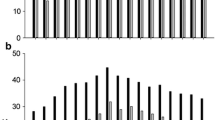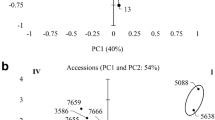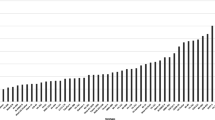Abstract
Limited knowledge about genetic and physiological traits associated with drought and low temperature stresses and narrow genetic diversity in Upland cotton (Gossypium hirsutum L.) are serious impediments in its genetic improvement. The objectives of this research were to determine the genetic and physiological traits associated with drought and low temperature effects and to identify chromosomal effects on these traits using chromosome substitution (CS) lines from three alien species of Gossypium, G. barbadense, G. tomentosum, and G. mustelinum, respectively. Two experiments were conducted to study low temperature and drought stress effects during seedling emergence and early growth stages in 21 cotton CS-lines with parent, Texas Marker (TM)-1. In Experiment I, plants were grown at optimum (30/22 °C) and low (22/14 °C) temperature conditions under optimum water and nutrient conditions. In Experiment II, plants were grown at optimum water (soil moisture content of 0.167 m3 m−3) and in drought (soil moisture content 0.105 m3 m−3) conditions under optimum temperature conditions. Above- and below-ground growth traits including several root traits of the CS lines were assessed at 25 days after sowing. The findings suggest which substituted chromosome or chromosome segment from the alien species likely harbors one or more genes for higher and lower tolerance to low temperature, respectively. CS-T04 and CSB08sh showed higher and lower tolerance to low temperature, respectively and CS-T04 and CS-B22sh showed higher and lower tolerance, respectively, to drought. CS lines are valuable analytical tool and useful genetic resources for targeted exploitation of beneficial genes for drought and low temperature stresses in Upland cotton.




Similar content being viewed by others
Abbreviations
- CS:
-
Chromosome substitution
- DAS:
-
Days after sowing
- SPAR:
-
Soil–Plant–Atmosphere-Research
References
Ashraf M (2002) Salt tolerance of cotton: some new advances. Crit Rev Plant Sci 21:1–30
Ball RA, Oosterhuis DM, Mauromoustakos A (1994) Growth dynamics of the cotton plant during water-deficit stress. Agron J 86:788–795
Basal H, Unay A, Canavar O, Yavas I (2009) Combining ability for fiber quality parameters and within-boll yield components in intraspecific and interspecific cotton populations. Span J Agric Res 7:364–374
Bland WL (1993) Cotton and soybean root system growth in three soil temperature regimes. Agric J 85:906–911
Bowman D, Gutiérrez O (2003) Sources of fiber strength in the US upland cotton crop from 1980 to 2000. J Cotton Sci 7:164–169
Bradow JM (1990) Chilling sensitivity of photosynthetic oil-seedlings. I. Cotton and sunflower. J Exp Bot 233:1585–1593
Burke JJ, Mahan JR, Hatfield JL (1988) A relationship between crop specific thermal kinetic windows and biomass production. Agron J 80:553–556
Chapple CS, Vogt T, Ellis BE, Somerville CR (1992) An Arabidopsis mutant defective in the general phenylpropanoid pathway. Plant Cell 4:1413–1424
Chinnusamy V, Schumaker K, Zhu JK (2004) Molecular genetic perspectives on cross-talk and specificity in abiotic stress signalling in plants. J Exp Bot 55:225–236
Christiansen MN, Thomas RO (1969) Season-long effects of chilling treatments applied to germinating cottonseed. Crop Sci 9:672–673
Costa C, Dwyer LM, Zhou X, Dutilleul P, Hamel C, Reid LM, Smith DL (2002) Root morphology of contrasting maize genotypes. Agron J 94:96–101
Gerik TJ, Faver KL, Thaxton PM, El-Zik KM (1996) Late-season water stress in cotton: I. Plant growth, water use, and yield. Crop Sci 36:914–921
Gerik TJ, Oosterhuis DM, Tolbert HA (1998) Managing cotton nitrogen supply. Advn Agron 64:115–147
Grimes DW, Yamada H, Dickens WL (1969) Functions for cotton (Gossypium hirsutum L.) production from irrigation and nitrogen fertilization variables: I. Yield and evapotranspiration. Agron J 61:769–773
Haldimann P (1997) Chilling-induced changes to carotenoid composition, photosynthesis and the maximum quantum yield of photosystem II photochemistry in two maize genotypes differing in tolerance to low temperature. J Plant Physiol 151:610–619
Hammer GL, Dong Z, McLean G, Doherty A, Messina C, Schussler J, Zinselmeier C, Paszkiewicz S, Cooper M (2009) Can changes in canopy and/or root system architecture explain historical maize yield trends in the US Cornbelt? Crop Sci 49:299–312
Hewitt EJ (1952) Sand and water culture methods used in the study of plant nutrition. CAB Commonw Agric Bur Technol Commun 22:189
Hodges HF, Reddy KR, McKinion JM, Reddy VR (1993) Temperature effects on cotton. Bulletin 990, Mississippi State University, Mississippi State, MS, p 10
Holaday AS, Mahan JR, Payton P (2016) Effects of chilling temperatures on photosynthesis. J Cotton Sci 20:220–231
Iqbal MJ, Reddy OUK, El-Zik KM, Pepper AE (2001) A genetic bottleneck in the ‘evolution under domestication’ of upland cotton Gossypium hirsutum L. examined using DNA fingerprinting. Theor Appl Genet 103:547–554
Jenkins JN, Wu J, McCarty JC, Saha S, Gutierrez OA, Hayes R, Stelly DM (2007) Genetic effects of thirteen Gossypium barbadense L. chromosome substitution lines in top crosses with Upland cotton cultivars: II. Fiber quality traits. Crop Sci 47:561–570
Johnson RM, Downer RG, Bradow JM, Bauer PJ, Sadler EJ (2002) Variability in cotton fiber yield, fiber quality, and soil properties in a southeastern coastal plain. Agron J 94:1305–1316. https://doi.org/10.2134/agronj2002.1305
Kakani VG, Reddy KR, Koti S, Wallace TP, Prasad PVV, Reddy VR, Zhao D (2005) Comparison of pollen and physiological characters of cotton cultivars as screening tools for high temperature tolerance. Ann Bot 96:59–67
Kaplan F, Kopka J, Haskell DW, Zhao W, Schiller KC, Gatzke N, Sung DY, Guy CL (2004) Exploring the temperature–stress metabolome of Arabidopsis. Plant Physiol 136:4159–4168
Kargiotidou A, Kappas I, Tsaftaris A, Galanopoulou D, Farmaki T (2010) Cold acclimation and low temperature resistance in cotton: Gossypium hirsutum phospholipase Dα isoforms are differentially regulated by temperature and light. J Exp Bot 61:2991–3001
Kornerova M, Hola D (1999) The effect of low growth temperature on hill reaction and photosystem 1 activities and pigment contents in maize inbred lines and their F1 hybrids. Photosynthetica 37:477–488
Lee JA, Fang DD (2015) Cotton as a world crop: origin, history, and current status. In: Lee LA, Fang DD (eds) Cotton, agronomy monograph no. 57. ASA, CSSA, and ASSA, Madion, pp 1–23
Lichtenthaler HK (1987) Chlorophylls and carotenoids: pigments of photosynthetic biomembranes. Methods Enzymol 148:350–382
Loka DA, Oosterhuis DM (2012) Water stress and reproductive development in cotton. In: Oosterhuis DM, Cothren JT (eds) Flowering and fruiting in cotton. The Cotton Foundation, Candova, pp 51–58
Lokhande S, Reddy KR (2014) Reproductive and fiber quality responses of Upland cotton to moisture deficiency. Agron J 106:1060–1069
Lu Z, Radin JW, Turcotte EL, Percy R, Zeiger E (1994) High yields in advanced lines of Pima cotton are associated with higher stomatal conductance, reduced leaf area and lower leaf temperature. Physiol Plant 92:266–272
Lu Z, Chen J, Percy RG, Zeiger E (1998a) Photosynthetic rate, stomatal conductance, and leaf area in two cotton species (Gossypium barbadense and Gossypium hirsutum) and their relation with heat resistance and yield. Aust J Plant Physiol 24:693–700
Lu Z, Percy RG, Zeiger E (1998b) Stomatal conductance predicts yields in irrigated Pima cotton and bread wheat grown at high temperatures. J Exp Bot 49:453–460
Lynch JP (2005) Root architecture and nutrient acquisition. In: BassiriRad H (ed) Nutrient acquisition by plants. An ecological perspective. Springer, Berlin, pp 147–183
Ma FY, Li MC, Yang JR, Ji XJ, Shentu XD, Tao HJ (2002) A study of effect of water deficit of three periods during cotton anthesis on canopy apparent photosynthesis and WUE. Sci Agric Sin 12:1467–1472 (in Chinese, with English abstract)
McKinion JM, Hodges HF (1985) Automated system for measurement of evapotranspiration from closed environmental growth chambers. Trans ASAE 28:1825–1828
McMichael BL, Upchurch DR, Burke JJ (1996) Soil temperature derived prediction of root density in cotton. Environ Exp Bot 36:303–312
McMichael BL, Oosterhuis DM, Zak JC, Beyrouty CA (2010) Growth and development of root systems. In: Stewart et al. JM (eds) Physiology of cotton. Springer, New York, pp 57–71
Morrow MR, Krieg DR (1990) Cotton management strategies for a short growing season environment: water–nitrogen considerations. Agron J 82:52–56. https://doi.org/10.2134/agronj1990.00021962008200010011x
Murray FW (1967) On the computation of saturation vapor pressure. J Appl Meteorol 6:203–204
Nie GY, Baker NR (1991) Modifications to the thylakoid composition during development of maize leaves at low temperatures. Plant Physiol 95:184–191
Onder D, Akiscan Y, Onder S, Mert M (2010) Effect of different irrigation water level on cotton yield and yield components. Afr J Biotech 8:1536–1544
Pembleton KG, Donaghy DJ, Volenec JJ, Smith RS, Rawnsley RP (2010a) Yield, yield components and shoot morphology of four contrasting alfalfa (Medicago sativa) cultivars grown in three cool temperate environments. Crop Past Sci 61:503–511
Pembleton KG, Smith RS, Rawnsley RP, Donaghy DJ, Humphries AW (2010b) Genotype by environment interactions of alfalfa (Medicago sativa L.) in a cool temperate climate. Crop Past Sci 61:493–502
Percival AE, Wendel JF, Stewart JM (1999) Taxonomy and germplasm resources. In: Smith WC, Cothren JT (eds) Cotton origin, history, technology and production. Wiley, New York, pp 33–63
Pettigrew WT (2004) Physiological consequences of moisture deficit stress in cotton. Crop Sci 44:1265–1272
Reddy KR, Hodges HF, Reddy VR (1992a) Temperature effects on cotton fruit retention. Agron J 84:26–30
Reddy KR, Reddy VR, Hodges HF (1992b) Effects of temperature on early season cotton growth and development. Agron J 84:229–237
Reddy KR, Hodges HF, McKinion JM (1993) A temperature model for cotton phenology. Biotronics 22:47–59
Reddy KR, Hodges HF, McKinion JM (1995) Carbon dioxide and temperature effects on Pima cotton development. Agron J 87:820–826
Reddy KR, Hodges HF, McKinion JM (1997a) Crop modeling and applications: a cotton example. Adv Agron 59:225–290
Reddy VR, Reddy KR, Wang Z (1997b) Temperature and aldicarb effects on cotton root growth and development. Biotronics 26:1–11
Reddy VR, Wang Z, Reddy KR (1997c) Growth responses of cotton to aldicarb and temperature. Environ Exp Bot 38:39–48
Reddy KR, Robana RR, Hodges HF, Liu XJ, McKinion JM (1998) Influence of atmospheric CO2 and temperature on cotton growth and leaf characteristics. Environ Exp Bot 39:117–129
Reddy KR, Read JJ, Baker JT, McKinion JM, Tarpley L, Hodges HF, Reddy VR (2001) Soil–Plant–Atmosphere-Research (SPAR) facility—a tool for plant research and modeling. Biotronics 30:27–50
Reddy KR, Prasad PVV, Kakani VG (2005) Crop responses to elevated carbon dioxide and interactions with temperature. In: Tuba Z (ed) Ecological responses and adaptations of crops to rising atmospheric carbon dioxide. Food Products Press, Binghamton, pp 157–191
Reddy KR, Brand D, Wijewardana C, Gao W (2017) Temperature effects on cotton seedling emergence, growth, and development. Agron J 109:1379–1387
Rizhsky L, Liang HJ, Shuman J, Shulaev V, Davletova S, Mittler R (2004) When defense pathways collide. The response of Arabidopsis to a combination of drought and heat stress. Plant Physiol 134:1683–1696
Rosolem CA, Assis JS, Santiago AD (1994) Root growth and mineral nutrition of corn hybrids as affected by phosphorus and lime 1. Commun Soil Sci Plant Anal 25:2491–2499
Roussopoulos D, Liakatas A, Whittington WJ (1998) Controlled-temperature effects on cotton growth and development. J Agric Sci 130:451–462
Saha S, Wu J, Jenkins JN, McCarty JC Jr, Gutierrez OA, Stelly DM, Percy RG, Raska DA (2004) Effect of chromosome substitutions from Gossypium barbadense L. 3-79 into G. hirsutum L. TM-1 on agronomic and fiber traits. J Cotton Sci 8:162–169
Saha S, Jenkins JN, Wu J, McCarty JC, Stelly DM (2008) Genetic analysis of agronomic and fiber traits using four interspecific chromosome substitution lines in cotton. Plant Breed 127:612–618
Saha S, Wu J, Jenkins JN, McCarty JC Jr, Hayes RW, Stelly DM (2010) Genetic dissection of chromosome substitution lines of cotton to discover novel Gossypium barbadense L. alleles for improvement of agronomic traits. J Theor Appl Genet 120:1193–1205
Saha S, Wu J, Jenkins JN, McCarty JC, Hayes R, Stelly DM (2013) Interspecific chromosomal effects on agronomic traits in Gossypium hirsutum by AD analysis using intermated G. barbadense chromosome substitution lines. Theor Appl Genet 126:109–117
Saha S, Stelly DM, Makamov AK, Ayubov MS, Raska D, Gutiérrez OA, Manchali S, Jenkins JN, Deng D, Abdurakhmonov IY (2015) Molecular confirmation of Gossypium hirsutum chromosome substitution lines. Euphytica 205:459–473
Saha S, Jenkins JN, McCarty JC, Hayes RW, Stelly DM, Campbell BT (2016) Four chromosome-specific (Gossypium barbadense chromosome 5sh) Upland cotton RILs with improved elongation. J Plant Regist 11:165–167
Senchina DS, Alvarez I, Cronn RC, Liu B, Paterson AH, Rong J, Noyes RD, Wing RA, Wilkins TA, Wendel JF (2003) Rate variation among nuclear genes and the age of polyploidy in Gossypium. Mol Biol Evol 20:633–643
Singh RP, Prasad PVV, Sunita K, Giri SN, Reddy KR (2007) Influence of high temperature and breeding for heat tolerance in cotton: a review. Adv Agron 93:313–385
Singh B, Borvell E, Wijewardana C, Wallace T, Chastain C, Reddy KR (2018) Assessing morphological characteristics of elite cotton lines from different breeding programmes for low temperature and drought tolerance. Euphytica. https://doi.org/10.1111/jac.12276
Snowden C, Ritchie G, Cave J, Keeling W, Rajan N (2013) Multiple irrigation levels affect boll distribution, yield, and fiber micronaire in cotton. Agron J 105:1536–1544. https://doi.org/10.2134/agronj2013.0084
Stelly DM, Saha S, Raska DA, Jenkins JN, McCarty JC, Gutierrez OA (2005) Registration of 17 Upland (Gossypium hirsutum) germplasm lines disomic for different G. barbadense chromosome or arm substitutions. Crop Sci 45:2663–2665
Tanksley SD, McCouch SR (1997) Seed banks and molecular maps: unlocking genetic potential from the wild. Science 277:1063–1066
Thomashow MF (1999) Plant cold acclimation: freezing tolerance genes and regulatory mechanisms. Ann Rev Plant Physiol Plant Mol Biol 50:571–599
Timlin D, Fleisher D, Kim SH, Reddy VR, Baker JT (2007) Evapotranspiration measurement in controlled environment chambers. Agron J 99:166–173
Udall JA, Wendel JF (2006) Polyploidy and crop improvement. Crop Sci 46:S3–S14
Ullah A, Sun H, Yang X, Zhang X (2017) Drought coping strategies in cotton: increased crop per drop. Plant Biotech J 15:271–284. https://doi.org/10.1111/pbi.12688
Upchurch DR, Mahan JR (1988) Maintenance of constant leaf temperature by plants. II. Experimental observations in cotton. Environ Exp Bot 28:359–366
Urano K, Maruyama K, Ogata Y, Morishita Y, Takeda M, Sakurai N, Suzuki H, Saito K, Shibata D, Kobayashi M, YamaguchiShinozaki K, Shinozaki K (2009) Characterization of the ABA-regulated global responses to dehydration in Arabidopsis by metabolomics. Plant J 57:1065–1078
Usadel B, Blasing OE, Gibon Y, Poree F, Hohne M, Gunter M, Trethewey R, Kamlage B, Poorter H, Stitt M (2008) Multilevel genomic analysis of the response of transcripts, enzyme activities and metabolites in Arabidopsis rosettes to a progressive decrease of temperature in the non-freezing range. Plant Cell Environ 31:518–547
Van Esbroeck GA, Bowman DT, May OL, Calhoun DS (1999) Genetic similarity indices for ancestral cotton cultivars and their impact on genetic diversity estimates of modern cultivars. Crop Sci 39:323–328
Wang R, Ji S, Zhang P, Meng Y, Wang Y, Chen B, Zhou Z (2016) Drought effects on cotton yield and fiber quality on different fruiting branches. Crop Sci 56:1265–1276
Wendel JF, Cronn RC (2003) Polyploidy and the evolutionary history of cotton. Adv Agron 78:139–186
Wijewardana C, Hock DL, Henry WB, Reddy KR (2015) Screening corn hybrids for cold tolerance using morphological traits for early-season seeding. Crop Sci 55:851–867
Zhu JK (2002) Salt and drought stress signal transduction in plants. Ann Rev Plant Biol 53:247–273
Acknowledgements
This work is partially supported by the USDA NIFA projects (2014-34263-22038, G-89701-1 and 2015-34263-24070, G-14901-1), Texas A&M Agrilife Research, and the Cotton Incorporated, Inc., USA. We would like to thank fellow graduate students for their help in taking measurements and processing samples in the lab. This study is a contribution of the Department of Plant and Soil Sciences, Mississippi State University, and the Mississippi Agricultural and Forestry Experiment Station.
Author information
Authors and Affiliations
Corresponding author
Ethics declarations
Conflict of interest
The authors declare no conflict of interest.
Rights and permissions
About this article
Cite this article
Awasthi, A., Reddy, K.R., Saha, S. et al. Morph-physiological responses of cotton interspecific chromosome substitution lines to low temperature and drought stresses. Euphytica 214, 218 (2018). https://doi.org/10.1007/s10681-018-2300-6
Received:
Accepted:
Published:
DOI: https://doi.org/10.1007/s10681-018-2300-6




